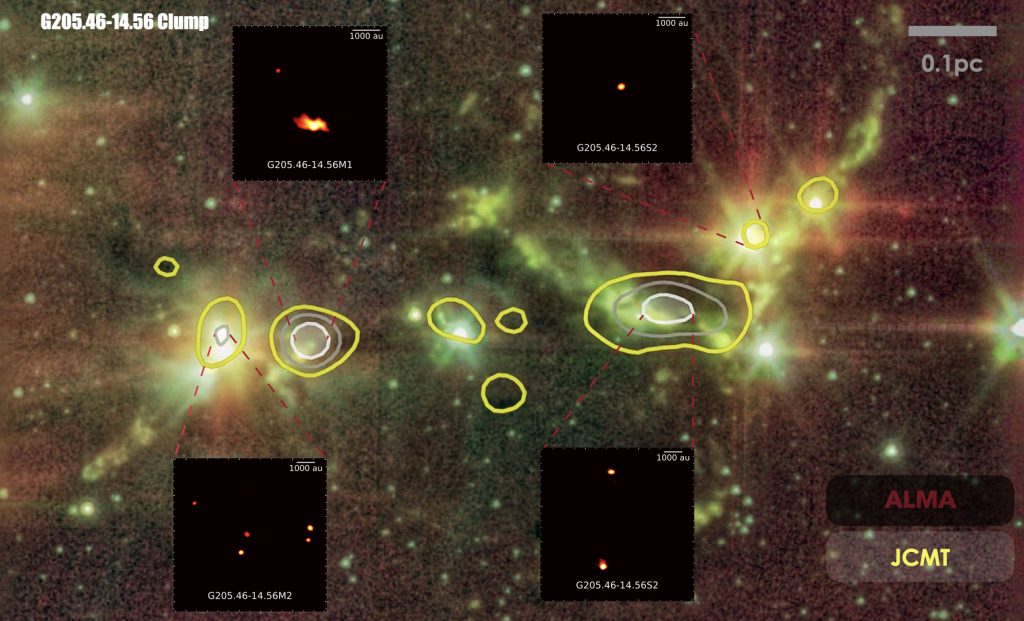Maunakea Hawaii – JCMT astronomers studying stellar nurseries, the birthplace of stars in our galaxy, have found that nearly half of stars in the Galaxy are formed in binary/multiple stellar systems (think twins, triplets, quadruplets). Despite the prevalence of binary/multiple births previous studies of stellar nurseries have concentrated more on how single stars form. The origin of binary/multiple stellar systems remains a mystery to astronomers.
The birth of all stars requires the gravitational collapse of cold dense pockets of gas and dust (known as cores) found in what are known as molecular clouds. However, previous investigations have rarely addressed how the properties of the host dense cores affect stellar multiplicity. To address this question a team of astronomers using the JCMT in Hawaii and ALMA telescope in Chile looked to the Orion Cloud complex – of the closest active star formation region. Located in the Orion constellation at about 1,500 light-years away this stellar nursery is an ideal laboratory for testing various models of star formation.
Using the JCMT telescope, astronomers identified 49 cold dense cores in the Orion clouds, locations which are in the process of forming young stars. The team then used the Atacama Large Millimeter/submillimeter Array (ALMA) to unveil the internal structures within these dense cores.

G205.46-14.56 clump located in Orion molecular cloud complex. The yellow contours stand for the dense cores discovered by JCMT, and the zoomed-in pictures shows the 1.3mm continuum emission of ALMA observation. These observations give insight into the formation of various stellar systems in dense cores.
Using the high-resolution ALMA observation, astronomers find that about 30% of the 49 cores are giving birth to binary/multiple stars, while the other cores are only forming single-stars. Astronomers then estimated the physical characteristics (size, density and mass) of these dense cores from the JCMT observations. Surprisingly, astronomers found that cores forming binary/multiple stars tend to show higher densities and higher masses than those cores forming single stars, although the sizes of various cores show no much differences. “This is understandable. Denser cores are much easier to fragment due to the perturbations caused by self-gravity inside molecular cores.” says Qiuyi Luo, a Ph.D. student at Shanghai Astronomical Observatory, who is the first author of this work published in The Astrophysical Journal.
The team also observed the 49 cores in N2H+ J=1-0 molecular line with the Nobeyama 45-m telescope. They found that N2H+ line widths of cores forming binary/multiple stars are statistically larger than that of cores forming single stars. “These Nobeyama observations provide a good measurement of turbulence levels in dense cores. Our findings indicate that binary/multiple stars tend to form in more turbulent cores”, says Prof.Ken’ichi Tatematsu, who lead the Nobeyama observations.
Summarizing the findings Qiuyi Luo said “In a word, we found that binary/multiple stars tend to form in denser and more turbulent molecular cores in this study”. Adding to this comment Sheng-Yuan Liu at ASIAA, co-author of this study stated “The JCMT has proven to be a great tool for uncovering these stellar nurseries for ALMA follow-ups. With ALMA providing unprecedented sensitivity and resolution so that we can do similar studies toward a much sample of larger dense cores for a more thorough understanding of star formation”.
As for future work, corresponding author and lead for the ALMA data Tie Liu, commented: “we have yet to look at the effect of magnetic fields in our analysis. Magnetic field may suppress the fragmentation in dense cores so we are excited to focus the next stage of our research on this area using the JCMT”.
This work was published: “ALMA Survey of Orion Planck Galactic Cold Clumps (ALMASOP): How Do Dense Core Properties Affect the Multiplicity of Protostars?” by Qiuyi Luo et al. in the Astrophysical Journal.
The work presented here was part of a wider collection of work with relevant links/publications provided below:
- JCMT SCOPE (SCUBA-2 Continuum Observations of Pre-protostellar Evolution): https://www.eaobservatory.org/jcmt/science/large-programs/scope/
- ALMASOP (ALMA Survey of Orion Planck Galactic Cold Clumps): https://ui.adsabs.harvard.edu/public-libraries/eKQmqMjaSsKk5DrvPEu-Vg
- The JCMT SPACE survey (Submilimeter Polarization and Astro-Chemistry in Earliest star formation): https://www.eaobservatory.org/jcmt/science/large-programs/space/



